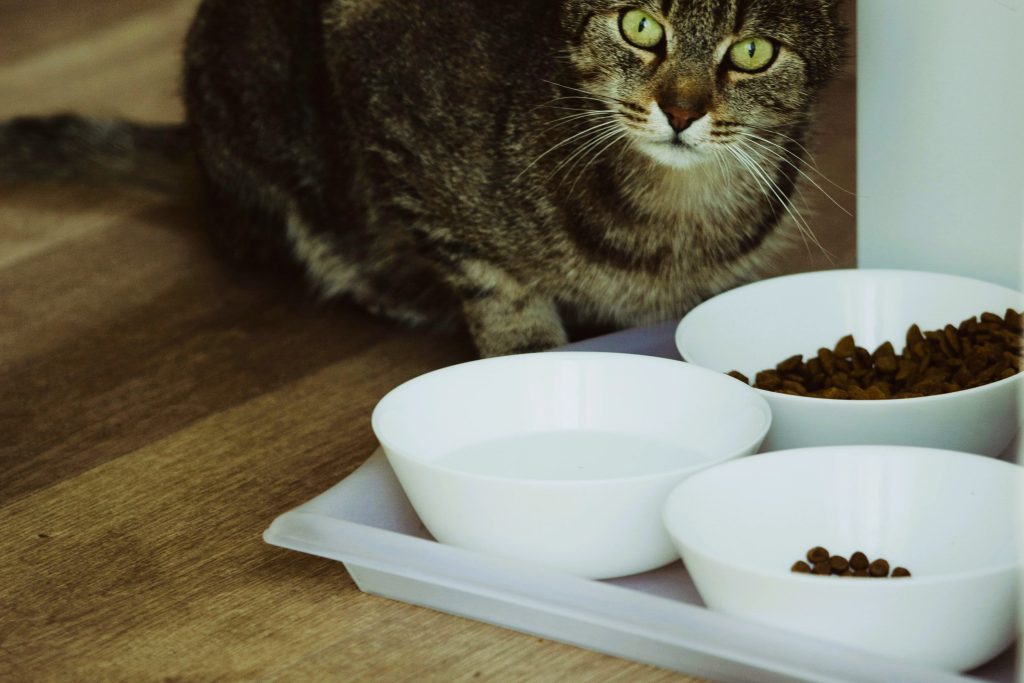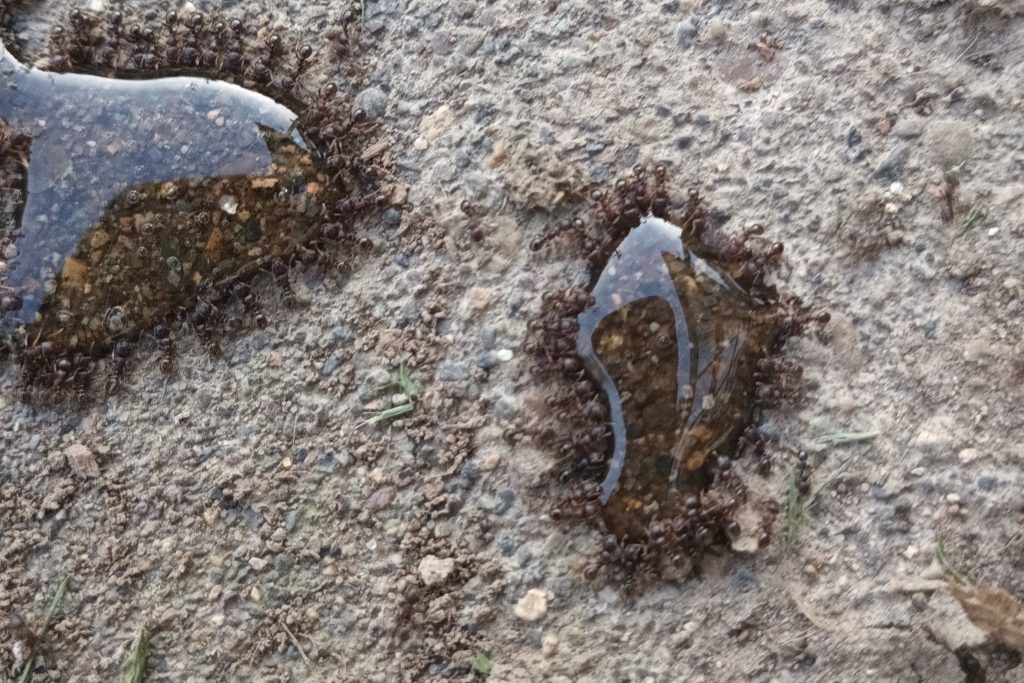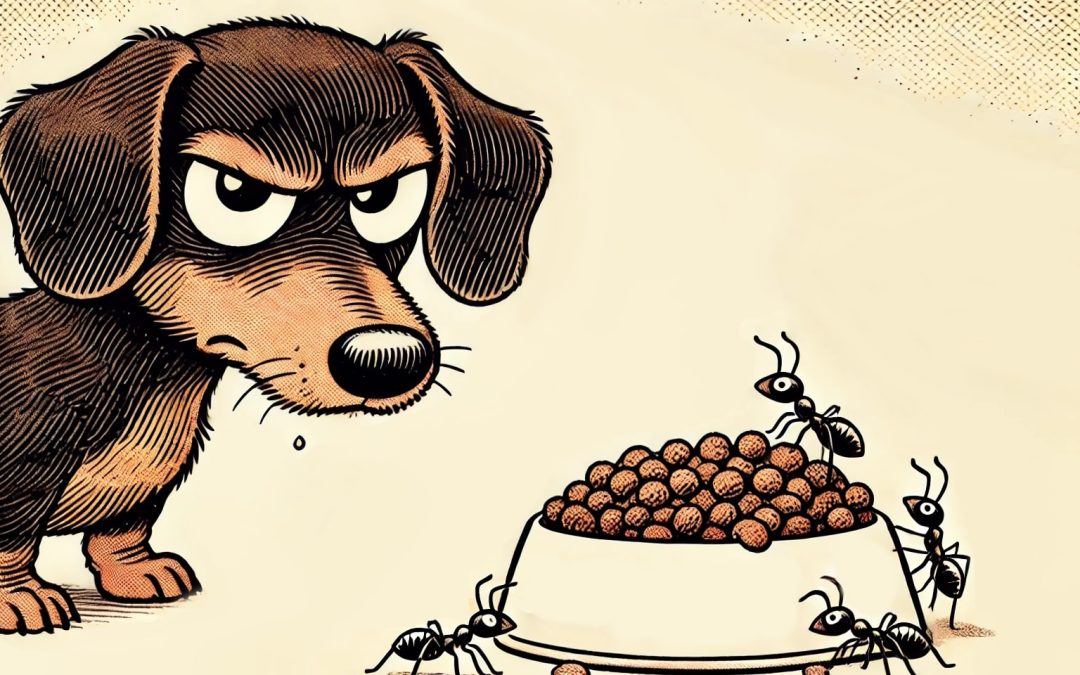Have you ever walked into your kitchen to find your cat or dog just staring at its food dish, looking downright offended? Then Mr. Wiggles gives you the look—the one that says, “Come on, human, you want me to eat this?”
Confused, you take a closer peek at the bowl. At first, everything seems fine—until you realize the kibble is moving. Then you spot them: a tiny, orderly army of ants marching in and out of your pet’s dish like they’ve just been invited to an all-you-can-eat buffet. Oh, come on!
Few things are more frustrating than dealing with ants in your pet’s food. They’re relentless, quick to discover even the smallest crumbs, and once they find a free meal, they’re not giving it up easily. But don’t worry—there are plenty of tricks to outsmart these tiny invaders and keep mealtime for Mr. Wiggles free from unwanted guests.
Key Takeaways
- Make it hard for ants to find the food.
- Store pet food properly.
- Maintain a clean area to help prevent trails from forming.
- Know when to call for help.
Why Do Ants Love Pet Food So Much?
Ants are natural foragers, always on the hunt for food. And what’s better than a reliable, high-protein, carbohydrate-rich meal served in a nice, easy-to-access dish? Whether it’s dry kibble, wet food, or even crumbs that missed the bowl, pet food is a jackpot for these tiny intruders.
The problem is, once a single scout ant finds that jackpot, it leaves a pheromone trail, essentially sending an open invitation to the rest of the colony. Within hours, you’ve got an ant highway leading straight to your pet’s food. Boom…Mr. Wiggles is upset.
Will ants in their food hurt my pet?
Ants are definitely a nuisance, but luckily, they’re not usually a serious threat to your cat or dog if a few end up in their food. In most cases, accidentally ingesting some ants won’t make your pet sick—it just adds a little extra crunch and protein to their meal.
However, there is one exception: ants that bite or sting. If aggressive species, like fire ants or velvety tree ants, get into the food, they could deliver a painful sting to your pet’s nose, lips, or mouth. That’s a mealtime surprise no one wants! Keeping ants out of your pet’s food isn’t just about convenience—it helps avoid those unwanted encounters.
Tips to Keep Ants Out of Pet Food
Use a Pet Food Tray with a Moat
If you want to stop ants in their tiny tracks, give them a challenge they can’t overcome—water.
How it Works: Place your pet’s food dish inside a larger, shallow tray filled with a small amount of water. Ants can’t swim, and they’ll be stopped before they reach the bowl.
What to Watch For: Make sure the moat isn’t too deep, especially for small pets, and change the water daily to prevent bacteria buildup.

Keeping ants out of pet food! This smart cat’s food dishes are placed in a tray with water to prevent unwanted pests from reaching its meal.
Purchase “Ant-Proof” Pet Bowls
Although not perfect, there are some good products available for purchase that are supposed to prevent ants from ever finding the food. A quick search online, or visit to your local pet store and you can find bowls such as THIS bowl from Chewy.com or THIS one from Amazon that could fit the bill nicely.
How to does it work: Depends on the specific design, but there are a couple things at play. Some bowls are engineered in a way that makes it hard for ants to crawl from the floor up to the food surface. Some are designed with a built-in moat that need to be kept filled with water. Whichever bowl you choose, make sure to read and follow the manufacturer’s instructions!
Elevate the Food Bowl
Ants are great climbers, but giving them fewer access points makes their mission harder. Elevating the food bowl can be an easy way to deter the ants just a little bit, although it isn’t fool-proof.
How to Do It: Use a pet food stand or raised platform to lift the dish off the ground. Some stands even come with smooth, slippery legs that ants struggle to climb.
Bonus: Elevating the dish can also make mealtime more comfortable for taller or older pets. Win-win!
Store Pet Food Properly
Leaving an open bag of kibble in the pantry is basically an open invitation to ants.
Use Airtight Containers: Transfer pet food into a sealed plastic or metal container to keep scents contained and pests out. Home Depot caries THESE containers which are super handy and keep the food protected.
Keep Food Off the Floor: Store food on a shelf or in a cabinet instead of leaving it where ants can find it.
Regular Cleaning: Wipe out storage containers before refilling them to remove lingering food dust and crumbs.
Keep the Feeding Area Clean
Even if Mr. Wiggles is a neat eater (which, let’s be honest… he’s definitely not), tiny crumbs and spills around the bowl can still attract ants.
Wipe Down the Area: Clean the floor and baseboards around your pet’s feeding station regularly.
Vacuum: A quick pass with a vacuum ensures no stray crumbs linger.
Wash the Bowl: Don’t just refill—give the bowl a good scrub to remove any food residue.

Pavement ants swarming a sugary liquid— any little crumb or spill can attract these tiny invaders!
What about ant deterrents?
If ants are still finding their way to your pet’s food, you might be inclined to escalate your efforts with some sort of deterrents like cinnamon, diatomaceous earth, or some aerosol can with a dead roach on it that you picked up from Home Depot. As a pest control professional, I highly recommend NOT using anything like this around your pets and their feeding areas. Even if it seems safe, you might be bringing on unintentional risk that your little fur ball does not need. Deterrents are great for some situations, but in this case, please leave it in the cabinet.
When to Call for Backup (a.k.a. Professional Help)
If you’re still battling these little pests, or finding ants everywhere, you might have a bigger problem on your hands. Persistent ant infestations can indicate colonies nesting in or around your home, and simple DIY fixes might not cut it.
That’s where the professionals come in. At Good Earth Pest Company, we specialize in identifying and eliminating ant infestations safely—without putting your pets at risk.
We find their entry points and nests.
We use pet-friendly treatments.
We help prevent future infestations.
Final Thoughts
Ants might be tiny, but they sure know how to cause a big headache. Luckily, a few simple changes—like adjustments to the food bowls, airtight storage, and keeping the feeding area clean—can make all the difference in keeping ants away.
So next time Mr. Wiggles gives you that look, you can reassure him that breakfast will be served ant-free. And if those pesky invaders still won’t back down, give us a call. We’re always here to help!



